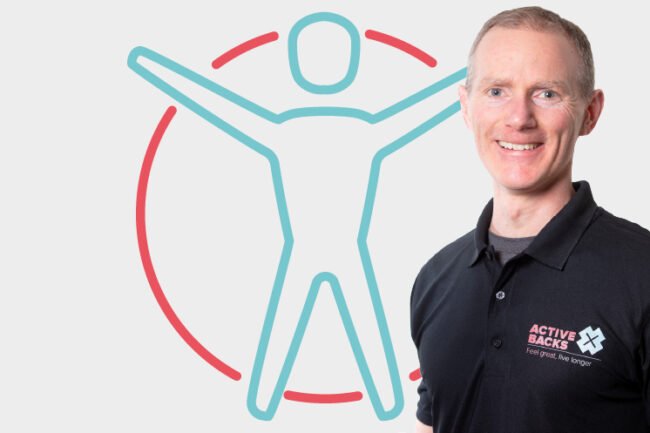Sitting down and lower back pain
Sitting down and lower back pain
This episode is entitled “Sitting down and lower back pain” and the topics covered are:
- Position
- Duration of sitting down with lower back pain
- Stillness
- Negative outlook on sitting down and lower back pain
- Previous volume of pain
- Golden rules for sitting down and lower back pain
Sitting down and lower back pain. There are no such things as pain nerves, but there are nociceptors. Noxious events, inflammation, trauma, very high, or very low temperature can cause your nociceptors to fire. What is it about sitting that could cause your nociceptors to fire? It will come down to two things: position and duration. Those two factors will determine whether your nociceptors fire.

Position
If you have inflammation in the area of the nociceptors, in your lower back, your nociceptors are likely to fire. Take your forefinger and push it back with the palm of the other hand, to the point where you have a little bit of discomfort. If I hold my finger in that position, my nociceptors will fire. Nociceptors are there to tell you to stop doing that. There’s a positional element. If you’re sitting in a position that puts your back under a degree of mechanical strain, your nociceptors are likely to fire and they will do it before you can cause any damage.
Duration of sitting down with lower back pain
The longer you hold that finger in that position for, the more those nociceptors are likely to fire. You can back off a little bit, take the strain off, but still hold it there for a prolonged period of time. Eventually the nociceptors will start to fire because they’re telling you that your tissues are fatiguing. And if you keep doing that, you are going to strain something and do yourself some damage.
Stillness
When you sit down, you’re staying in that position for a prolonged period of time, which is causing your nociceptors to fire. Movement without pain is one of the variables in the pain equation. The longer you sit still means you are not moving and moving without pain is one of the ways of reducing your pain. If you don’t want to hurt when you sit down, try not to sit still. I have a few exercises called the seated wobble. As you’re sitting in your chair, just wobble from cheek to cheek and your back will thank you for it. It likes movement.
Negative outlook on sitting down and lower back pain
If you are stressed, you’re likely to experience more pain. Your emotional centers are closely intertwined with your pain pathways. If you’re feeling good, really engaged in something you enjoy doing, you’re likely to have less pain. The more you think about your back being sore, the more sore it’s going to be.
Previous volume of pain
That refers to both the amount of pain you’ve had in the past and also the severity of the pain. The more severe your pain has been in the past, the worse your pain will tend to be. The more you do an activity that results in pain, the more your brain associates the two. There’s a saying in neurology: nerves that fire together wire together. The more frequently those nerve pathways fire, the more they become hardwired into your central nervous system.
Golden rules for sitting down and lower back pain
Use it or lose it, but don’t abuse it. The biological purpose of pain is an alarm system. If you do something that hurts, don’t do that or don’t do it in the way that you have been doing it. The more you expose your body and your nervous system to painful stimuli, the more likely you are to experience pain in the future. You’ve come to associate that activity with pain. On the other hand, if you don’t use it, you will lose it.
Your best posture is your next posture. People think there’s a perfect way of sitting, so they sit that way repeatedly and for long periods. The problem is that’s a prolonged posture. Variety is the spice of life.
Start low and build slow. If you are having problems with sitting, don’t eliminate it entirely. You may need to for a very short period, but you want to get back to it without pain at a low level. Do a little bit of sitting. Maybe for a minute or two, and then slowly build up the duration. That way you can gradually rehabilitate back to being able to sit for more prolonged periods.


